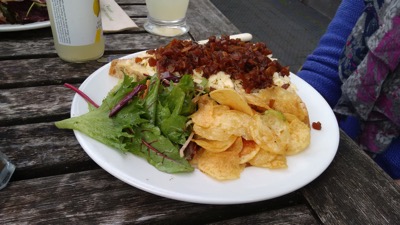After lunch at the nearby Duchy of Cornwall Nursery of a

Davidstowe Open Cheese sandwich (very good)

and a Cheese and Onion Cornish Pasty (ok),
it was off to a National Trust Tudor House at Cotehele near Saltash on our way to Yeovil where we were staying the night.
Cotehele
Parts of this house date from around 1300 although the majority dates from 1485 making it one of the least altered Tudor Houses in England. As well as the house, there is a boathouse and boat on the Quay below and a working mill. Our first impression was of a beautifully kept and unspoilt house.
Being the end of the season, it was reasonably quiet and there were not many visitors inside.
Once in the inner courtyard, the door leads into an inner hall where hanging on the wall
is a most unusual exhibit, namely a false arm made by armourers to replace one lost in battle. The National Trust website provides this additional story
Terrible injuries on the bloody battlefields of Europe in the 16th and 17th centuries led surgeons to design elaborate prostheses for lost limbs. These were usually made by armourers and the moveable fingers in this mechanical vambrace can lock into place, enabling a soldier to grip his reins or sword.
It’s not known how this rare survivor of a brutal period in European history came to Cotehele in Cornwall, but in 1947 the Earl of Mount Edgcumbe related a story of his father’s late-night encounter with this most unusual piece of armour.
Awakened in the middle of the night by a sound of someone breaking a window, the Earl groped his way in the dark, searching for a pair of ancient pistols hanging on the wall of the Banqueting Hall. Suddenly, he felt his wrist tightly gripped by cold fingers. Grappling to free himself, he fled back to his bedroom in horror. The next morning, in braver mood, he discovered that the fingers belonged to the mechanical arm and that the burglar had been a cow, scraping her horns against the window bars.
Although the Earl was adamant that Cotehele was never haunted, others beg to differ and believe that this atmospheric Tudor house has more than a whiff of the paranormal about it.
When we were researching Cotehele after our visit, we came across a National Trust Website here (set for Cotehele) which enables you to search its collections for images and explanations about the various objects it cares for.
I shall remember the house most for its numerous Tapestries. Whilst I have seen them in better condition elsewhere (Houghton Hall comes to mind), the quantity and the way in which they are still an integral part of the original room was something to remember.
There is no electricity in most of the house and hence we saw them with what little natural
light came in through the small windows on a late autumn day and also with the help of torches provided by the volunteer guides in each room.
A few of the tapestry have almost equally old mirrors in the middle of them.
This tapestry is "Boys Pouring Wine" c 1670 possibly made in London.
Even the four poster bed in The White Room comes with tapestries. There is a lot to see here including a very old original tower clock.
There is a comprehensive but concise description of Cotehele here and far more to see and enjoy than I have described.
No comments:
Post a Comment